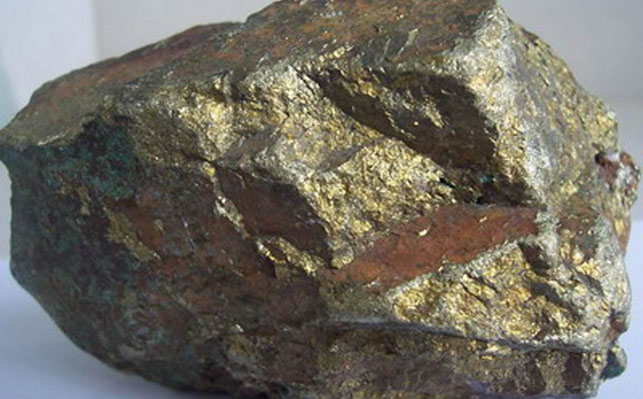Porphyry copper mines account for a large proportion of the world's copper mines and are widely distributed, but most porphyry copper mines have low grades and are difficult to beneficiate. The technologies currently commonly used for beneficiation of porphyry copper mines include flotation, gravity separation, magnetic separation and chemical separation, each of which has its own advantages and disadvantages.
In addition to these commonly used technologies, research on the beneficiation of porphyry copper mines has been ongoing in recent years. Combined beneficiation and smelting, biological beneficiation, and automated intelligent beneficiation have also appeared in copper mine beneficiation plants, becoming a new development trend.

The mineral composition of porphyry copper ore is relatively complex. In addition to copper, it usually includes metal elements such as iron, sulfur, gold, and silver. Although the copper content is relatively high, it is often associated with iron and sulfur, which makes the extraction and recovery of copper difficult.
Common porphyry copper ores include chalcopyrite, pyrite, chalcopyrite arsenic ore, and chalcopyrite antimony ore, which need to be separated according to the physical and chemical properties of the minerals. The particle size of porphyry copper ore is relatively fine, between 0.1 and 0.5 mm.
2.1. Flotation
Flotation is a method of separating and recovering copper by utilizing the difference in floatability between copper and other gangue minerals. It is a common method for beneficiation of porphyry copper ores. In the flotation process, the selection of flotation reagents is very important, and the design of the flotation process is also related to the final grade of the concentrate.
(1) Flotation reagents
Collectors and depressants are key reagents for flotation of porphyry copper ores.
Collectors can be divided into non-ionic collectors, ionic collectors, combined collectors, and new collectors. In addition to some commonly used single collectors, combined collectors are increasingly used, that is, a mixture of two or more collectors, which has better flotation effect than a single collector.
Among the depressants commonly used in the flotation of porphyry copper ores, there are: sodium sulfide, phosphinothion, arsenothion, sodium hypochlorite, peroxide, percarbate, dichromate, ferrocyanide, etc.
(2) Flotation process
A reasonable flotation process is the key to obtaining high-grade concentrate and high recovery rate. The flotation process usually includes roughing, concentrating and scavenging.
In the roughing stage, collectors and frothers are added to the pulp, and the copper minerals are combined with bubbles through the flotation machine to form roughing concentrate.
In the concentrating stage, the roughing concentrate is concentrating for multiple times to gradually improve the copper grade.
In the scavenging stage, the roughing tailings are scavenged for multiple times to recover the valuable metals in them and improve the recovery rate.
2.2. Gravity separation
Gravity separation technology mainly uses the density difference between copper and gangue minerals to achieve copper separation and recovery. Therefore, the scope of application of gravity separation is small, and it is only applicable to situations where the specific gravity difference between copper minerals and other minerals is large. Although gravity separation is simple to operate and has low investment cost, its fatal shortcomings are small scope of application, low beneficiation efficiency, and low recovery rate.
2.3. Magnetic separation
Magnetic separation is mainly used to separate magnetic minerals in ores, such as magnetite. For porphyry copper ore containing magnetic minerals, magnetic separation can effectively remove these impurities and improve the grade of copper minerals. Magnetic separation equipment includes permanent magnetic drum magnetic separators and electromagnetic magnetic separators.
2.4. Chemical beneficiation
The chemical beneficiation process includes leaching, extraction, and electrolytic deposition. Leaching is to dissolve the copper in the ore into the solution. Commonly used leaching agents are sulfuric acid and bacterial leaching agents.
In order to better improve the grade of copper concentrate and the recovery rate of mineral processing, professionals at home and abroad are also constantly exploring the mineral processing technology of porphyry copper mines. The methods that have been tested in practice and have good results are mainly:
3.1. Combined metallurgical process
The combined mineral processing and smelting process refers to the combination of mineral processing and smelting. Only partial recovery and separation are carried out in the mineral processing stage, and the mixed ore is sent to the smelting stage for complete separation.
An example of a successful integrated beneficiation and smelting project is the Duobaoshan Copper Mine in Heilongjiang, which has achieved remarkable results by adopting the integrated beneficiation and smelting process of "moderate separation of copper and molybdenum by mineral processing - thorough separation and recovery of copper and molybdenum by metallurgical chemical industry".
3.2. Bio-mineral processing technology
Bio-separation technology uses the metabolism of microorganisms to dissolve copper in ore into solution. This technology has the advantages of environmental protection and low cost, and is suitable for low-grade and difficult-to-select porphyry copper mines.
3.3. Automated and intelligent mineral processing
Today's mineral processing plants reflect the impact of high technology on the mineral processing industry everywhere. Automation and intelligence have been applied to most of the plants. Standardized operations not only reduce errors in manual operations, but also improve mineral processing efficiency and recovery rates.
For example, through online detection technology, various parameters in the mineral processing process, such as slurry concentration, pH value, reagent concentration, etc., can be monitored in real time to achieve automatic control of the mineral processing process.
The above is an introduction to the beneficiation technology of porphyry copper ore and the current new research progress. With the continuous development and progress of science and technology, I believe that people will make higher utilization of mineral resources in the future.